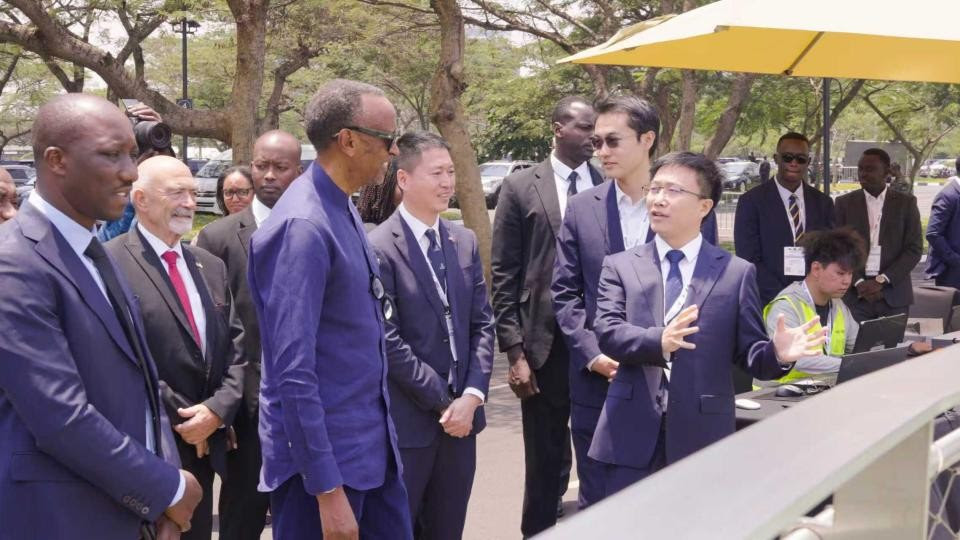EHang Holdings Limited, a global leader in urban air mobility (UAM) technology, marked a historic achievement by conducting the first pilotless, human-carrying electric vertical take-off and landing (eVTOL) flight in Africa. This groundbreaking event occurred at the 9th Aviation Africa Summit in Kigali, Rwanda, in collaboration with its strategic partner, China Road and Bridge Corporation (CRBC).
The successful flight of the EH216-S aircraft represents a significant step forward in integrating advanced air mobility solutions into the African continent, showcasing the potential of pilotless eVTOL technology to transform transportation.
Historic flight demonstration
The EH216-S, EHang’s flagship autonomous eVTOL aircraft, completed its inaugural pilotless human-carrying flight in Africa during the 9th Aviation Africa Summit in Kigali, Rwanda. The event, held in 2025, was supported by the Rwanda Civil Aviation Authority (RCAA), which ensured regulatory compliance and safety oversight.
Prominent figures, including Rwandan President Paul Kagame, Minister of Infrastructure Dr. Jimmy Gasore, RCAA Director General Silas Udahemuka, and Chinese Ambassador to Rwanda Wenqi Gao, witnessed the flight, underscoring its diplomatic and technological significance. Aviation professionals and media from over 50 countries, along with EHang’s Chief Engineer Rucheng Lu, attended the ceremony, with RCAA staff and China Media Group reporters among the first passengers.
Critical Insight: The presence of high-profile dignitaries highlights the flight’s role as a catalyst for bilateral cooperation between China and Rwanda, aligning with the Belt and Road Initiative’s focus on technological exchange. The successful execution under RCAA oversight demonstrates Rwanda’s progressive regulatory environment, positioning it as a potential hub for UAM in Africa.
Significance for African aviation
The EH216-S flight marks a pivotal moment for African aviation, introducing pilotless eVTOL technology to a continent with vast geographical and infrastructural challenges. The Aviation Africa Summit, one of Africa’s largest aviation events, provided a platform to showcase the EH216-S to a global audience, attracting visitors from Africa, Europe, the Middle East, and Asia. The aircraft’s display at EHang’s booth facilitated discussions on low-altitude economy cooperation, with dignitaries like President Kagame and Ambassador Gao exploring its potential applications.
President Kagame praised the flight’s safe and reliable performance, stating, “This impressive demonstration will drive the development of low-altitude transportation in Africa.” Similarly, Ambassador Gao emphasized its role in deepening China-Rwanda technological collaboration, while Dr. Gasore highlighted Rwanda’s commitment to developing a regulatory framework for advanced air mobility.
Critical Insight: The flight’s success underscores the transformative potential of eVTOL technology in addressing Africa’s transportation challenges, particularly in remote areas where traditional infrastructure is limited. However, the adoption of such technology requires robust regulatory frameworks and public acceptance, areas where Rwanda’s proactive stance provides a model for other African nations.
Strategic expansion in Africa
Africa’s diverse geography, with its mix of urban centers and remote regions, presents unique opportunities for UAM. The EH216-S flight serves as a proof-of-concept for future commercial applications, such as passenger transport, logistics, and tourism. EHang, in partnership with CRBC, aims to leverage its expertise in autonomous aerial vehicle technology to expand into the African market. Qilin Huang, Head of CRBC’s Rwanda Office, described the flight as a “showcase of China’s cutting-edge technology,” signaling opportunities for further eVTOL deployment.
EHang’s Chief Engineer, Rucheng Lu, noted that the EH216-S has completed over 73,000 safe flights globally, with its African debut expanding its footprint to 21 countries across five continents. Lu emphasized EHang’s commitment to collaborating with African airlines, airports, and civil aviation authorities to develop innovative UAM models tailored to the continent’s needs.
Critical Insight: While EHang’s technology demonstrates technical maturity, scaling UAM in Africa requires addressing challenges such as infrastructure costs, energy supply for electric aircraft, and workforce training. Partnerships with organizations like CRBC can facilitate market entry, but long-term success hinges on aligning solutions with local economic and social contexts.
Implications for the low-altitude economy
The introduction of pilotless eVTOL technology in Africa aligns with the global shift toward the low-altitude economy, which encompasses innovative air mobility solutions for urban and rural environments. The EH216-S’s capabilities autonomous operation, electric propulsion, and vertical take-off and landing position it as a versatile tool for addressing transportation inefficiencies. In Africa, where road infrastructure is often limited, eVTOLs could enhance connectivity, support economic growth, and improve access to services in underserved regions.
Rwanda’s leadership in embracing UAM reflects its broader vision of leveraging technology for development, as seen in its drone delivery programs for medical supplies. The EH216-S flight sets a precedent for other African nations to explore similar innovations, with EHang and CRBC poised to drive regional adoption.
Critical Insight: The low-altitude economy offers significant potential for Africa but requires careful integration with existing aviation systems. Regulatory harmonization across African nations, investment in charging infrastructure, and public-private partnerships will be critical to scaling eVTOL applications effectively.



